Therapeutic molecules for multiple human diseases identifie from pigeon pea(Cajanus cajan L.Millsp.)through GC-MS and molecular docking
Deepu Mathew,Lidiya John P.,Manila T.M.,Divyasree P.,Sandhya Rajan V.T.K.
Finishing School in Biotechnology,Centre for Plant Biotechnology and Molecular Biology,Kerala Agricultural University,Thrissur,Kerala 680 656,India
Abstract Molecular mechanism behind the therapeutic potential of pigeon pea over the human diseases such as rheumatoid arthritis,breast cancer,type II diabetes,malaria,measles and sickle cell disease were revealed through docking of GC-MS identifie phyto-compound ligands with candidate disease proteins.Of the 242 ligands,three dimensional structures of 47 compounds had to be drawn using ChemSketch and the remaining structures were retrieved from PubChem and docked with the active sites of candidate proteins.The molecules identifie through docking were further subjected to ADMET analysis and promising drug candidates were identifie for each disease.This paper presents a precise account of the chemoprofil of pigeon pea leaves,stems and seeds,interaction of these molecules with target proteins and suggests 26 highly potential molecules which are drug candidates for multiple human diseases.Pigeon pea seeds are especially proven as invaluable source for therapeutic molecules.
Keywords: Breast cancer;Drug discovery;Herbal medicine;In silico;Malaria;Measles;Phyto-compounds;Rheumatoid arthritis;Sickle cell disease;Type II diabetes
1.Introduction
Pigeon pea,also known as red gram and commonly cultivated in the semi-arid tropics,is regarded for its nutritional significanc as well as medicinal properties [1-4].Different parts of this plant are used in traditional medicine in China and Brazil [5].The antioxidant [6-8],antidiabetic [9],antimicrobial [10,11],DNA damage protective and xanthine oxidase inhibitory[12]properties of this plant are generally established.Extracts from this crop are reported effective for the treatment of diabetes,dysentery and hepatitis[13].Leaves have been useful for the treatment of wounds,bedsores,malaria and diet induced hypercholesterolemia [14,15]whereas,the seeds are sedative and used to treat cough,hepatitis,plasmodial diseases and diabetes[16,17].In most of these cases,the effector molecules need to be identifie and characterized.
Chemical investigations have been successful to bring out the major molecules from each part of the plants,especially the leaves and seeds.Leaves are rich in polyphenolic compounds such as luteolin and apigenin [18],flvonoids such as genistein and genistin [17],anticancerous antiflvone cajanol[19],stilbenes such as cajaninstilbene acid (CSA) and pinostrobin[8,20-22],antibacterial coumarin cajanuslactone[23]and cajaminose,phenylalanine,and hydroxybenzoic acid with antisickle cell disease effects[24,25].
Each human disease is understood to have incited by the activity of viral or human proteins.Phyto-compounds which have the potential to interact with these proteins,hereafter designated as the target proteins,could be considered as candidate drug molecules.GC-MS is a high through-put metabolomics platform which allows the separation and identificatio of the active compounds in biological substrates.Once the active phyto-compounds are identified thein silicomolecular docking techniques enable the analysis of successful interaction of these phyto-compounds with the active sites of target proteins.Thus,sequential application of GC-MS andin silicodocking is a potential strategy to identify novel drug molecules.In this study,we report the findin of active molecules which are highly potentialdrugcandidatesforthehumandiseasessuchasrheumatoid arthritis,breast cancer,type II diabetes,malaria,measles and sickle cell disease,from pigeon pea,a plant with numerous proven medicinal properties.These diseases were specificall chosen since the target proteins are proven and their tertiary structures are well characterized so that each identifie phytocompound could be accurately docked.
Rheumatoid arthritis(RA)is an autoimmune response leading to chronic inflammator disorder.Nitric oxide (NO) is a small,diffusible and unstable radical that plays a major role in many physiological and pathological processes.Excess production of NO was implicated in RA,contributing to T-lymphocyte dysfunction.Synthesis of NO fromL-arginine using NADPH and molecular oxygen is governed by the enzyme inducible NO Synthase with N-terminal oxygenase domain(iNOSox).Dimerization of oxygenase N-domains of two NOS proteins activates the iNOSox enzyme[26].NO-dependent tissue injury has been observed in a variety of rheumatic diseases[27].Thus,the oxygenase domain of NOS protein is the best target for screening the anti-RA ligands.
Breast cancer is the most common female cancer world-wide and annually,more than 1 million are affected and 0.4 million die[28].Over-expression of Polo-like kinase 1(Plk1)protein is found in cells infected with breast,ovarian,colorectal,uterine,skin or stomach type of cancers[29].Plk1 is a member of Pololike kinase family of serine/threonine-protein kinases involved in the regulation of cytokines and cell-cycle progression and hence considered as an attractive target for the anticancer therapeutics development[30].
Type IIDiabetes mellitushas been a global health threat[31-33].Two major hormones involved in the endocrine signaling from gut are glucagon-like peptide-1 (GLP-1) and glucose-dependent insulinotropic polypeptide (GIP) [34].The action of GLP-1 is inactivated by the proteolytic activity of dipeptidyl peptidase IV (DPP-IV).By inhibiting DPP-IV,the level of GLP-1 could be increased in blood,releasing adequate insulin[35].Hence the molecules which are capable to interact and suppress DPP-IV protein may be considered as promising diabetes drug candidates.
Common anti-malarial drugs quinolines and antifolates are feared to have side effects[36,37].Plasmepsin II,aspartic acid protease having 2-aspartic acid residues in the active site,is a hemoglobin-degrading enzyme produced by the plasmodium parasite.Malaria parasite requires this protease for the digestion of hemoglobin and release of nutrients.Hence,Plasmepsin II has to be considered as a target protein for anti-malarial drugs.
Measles is a highly infectious and potentially fatal viral infection,mainly in children.Annually,nearly 0.1 million Indian children die of this disease,amounting to 4 per cent of country’s under-5 deaths [38].C.cajanstem extracts inhibit the cytopathetic effect of the virus on Hep-2 tissue[39].Intercellular adhesion molecule 1(ICAM-1)along with CD46 and CD4 are identifie as the virus-binding receptor proteins in humans[40].The expression of ICAM-1 by endothelial cells is important for the regulation of adhesion andtrans-endothelial migration of a variety ofleukocytes that express the integrins lymphocyte function-associated antigen 1(LFA-1)[41].
Sickle cell disease is an autosomal recessive disorder,resulting from the mutation of the sixth amino acid in the β-globin gene changing from polar glutamic acid to non-polar valine[42].There exists a necessity to develop natural product based drugs to manage this anemic condition.A herbal preparation fromC.cajanwith the active constituents phenylalanine,carjaminose,and hydroxybenzoic acid had anti-sickling effects [43]and a detailed review on anti-sickling property of this crop is given by Imaga[44].The replacement of amino acid in OxyHb protein of hemoglobin reduces the solubility and leads to its precipitation in erythrocytes,making the erythrocytes elongated and rigid.Deformation and stiffness of erythrocytes is the primary cause of the disease and is the feature that distinguishes sickle cell disease associated anemia from anemia caused by other abnormal hemoglobins[45].
Since pigeon pea is proven to have therapeutic potential against a large spectrum of human diseases,this study was taken up to test the hypothesis that various parts of this crop harbors phyto-compounds which got the potential to interact with the active sites of the target proteins of human diseases rheumatoid arthritis,breast cancer,type II diabetes,malaria,measles and sickle cell disease and hence could be the potential drug candidates.Thus,apartfromrevealingthelargespectrumofmolecules in every part of this plant,this study will reveal the molecular mechanisms behind its reported therapeutic activities and identify the novel drug candidates.Further,identifying the spectrum of molecules shall open up the path to identify the drug candidates for other human and diseases and for better understanding on the mechanisms behind each activity.
2.Materials and methods
2.1.Plant material
The whole plants of pigeon pea were collected from National Pulse Research Institute,Tamil Nadu Agricultural University,Vamban,India.Leaves,stems and seeds were separated,shade dried,pulverized coarsely and stored in sealed plastic bags within air tight containers.
2.2.Extraction of samples
Phyto-compounds were extracted separately from leaves,stems and seeds,following the continuous hot sequential soxhlet extraction method [46].Solvents hexane,ethyl acetate and methanol with polarity of 0.1,4.4 and 5.1,respectively,were used for the extraction.Fifty gram of each sample was extracted using 500 mL of each solvent in the order ofincreasing polarity,starting from hexane followed by ethyl acetate and methanol(40-60°C)for a period of 8-10 h.The extracts were filtere in each step through Whatman No.1 filte and concentrated using water bath and evaporation.
2.3.Gas chromatography-mass spectrometry(GC-MS)
The phyto-compounds in the extracts were identifie through standard GC-MS analysis [47](VARIAN CP 3800-GC and SATURN 2200-MS equipped with a type capillary column Varian FactorFour VF-5 ms poly-5% phenyl-95%-dimethyl-siloxane bonded phase column (0.25 mm; length 30 m; fil thickness 0.15 μm)) followed by interpretation ofiname,molecular weight and structure of the components of mass spectrum using NIST/EPA/NIH Mass Spectral Library (Data Version:NIST 14,Software Version 2.2 g,https://www.nist.gov/srd/nist-standard-reference-database-1a-v14).
2.4.Molecular docking
The phyto-compound ligands were used for molecular docking with target protein for each disease,using Discovery Studio v.4.0 software.
2.4.1.Preparation of target protein
Three dimensional structures of protein targets retrieved from PDB were prepared by removing water molecules,heteroatoms and ligands using‘Prepare protein’option in Discovery Studio andthecorrectionoftargetswerecarriedoutbyenergyoptimization and adding hydrogen atoms.The target proteins identifie for arthritis,breast cancer,type II diabetes,malaria,measles and sickle cell disease were iNOSox (PDB ID - 3E7G),polo-like kinase 1(2RKU),dipeptidyl peptidase IV(5T4B),Plasmepsin II(3F9Q),ICAM-1(1IAM)and OxyHb(1GZX),respectively.Active sites of the target were predicted using‘Receptor cavity method’option in the software supplemented with information retrieved from the literature.
2.4.2.Preparation ofligands
The 3D structures ofligands available at PubChem have been retrieved and for rest of the ligands,structures were drawn using ChemSketch software.All ligands were prepared and then screened on the basis of Lipinski’s rule to evaluate drug-likeness and to determine its pharmacological activity through molecular docking.
2.4.3.Molecular docking
Molecular docking of the prepared ligands and proteins was performed using the CDOCKER algorithm [48]implemented in Discovery Studio,with default parameters.CDOCKER is a grid-based molecular docking method which holds the protein rigid while the ligands are allowed to flx during the process.The ligands were docked into the active site and binding affinit was calculated using CDOCKER energy and
CDOCKER interaction energy.CDOCKER energy is a total ofinternal ligand strain energy and receptor-ligand interaction energy,whereas CDOCKER interaction energy indicates receptor-ligand interaction.Scoring functions such as number of hydrogen bonds interacting with the active site residues,H-bond distance (A°),CDOCKER energy,CDOCKER interaction energy were initially calculated.The interacting poses with high CDOCKER energy,CDOCKER interaction energy,and maximum number of hydrogen bonds were selected for binding energy (ΔG binding),protein energy and complex energy (kcal/mol) predictions.Interactions offering maximum number of hydrogen bonds,H-bond distances ofless than 3A°,CDOCKER and CDOCKER interaction energies less than-20 kcal/mol,minimal difference among the CDOCKER and CDOCKER interaction energies (preferably less than-10 kcal/mol),binding energy less than -100 kcal/mol,protein energy and complex energy less than-2000 kcal/mol,were considered as good interactions[49,50].
2.4.4.ADMET analysis
Promising ligands identifie from molecular docking studies were subjected to cytotoxicity prediction of drugs using ADMET analysis using the ADME/T module of Discovery Studio.The module has calculated the absorption,distribution,metabolism,excretion and toxicity values,following the established formulae [51,52].Molecules with desirable properties such as solubility in the range of 2.0-4.0,absorption in the range of 0.0-1.0,AlogP98 value less than 4.0,false CYP2D6 and hepatotoxicity predictions and true PPB prediction value were considered as best drug candidates.
3.Results
A total of 320 phyto-compounds were identifie through GC-MS analysis and after removal of duplicates from extracts of different plant parts,the number of compounds was found to be 242 (Table1).Three dimensional chemical structures of 195 compounds were retrieved from PubChem database and structures of 47 compounds were drawn using ChemSketch(Supplementary Table1,Supplementary Figs.1a-ih).
The active sites for target proteins in each disease are listed in Table2.Analyzing every phyto-compounds with every active site of the target proteins has resulted in 1920 docking at 11,520 sites and for every successful interaction,CDOCKER energy and CDOCKER interaction energy,difference between CDOCKER energy and CDOCKER interaction energy and number of hydrogen bonds were recorded.For interactions with satisfactory values for these factors(Refer 2.4.3),binding energy,protein energy and complex energy were assessed.
From the 242 phyto-compounds analyzed,13 (three each from leaves and stem and seven from seeds) have shown satisfactory interaction with iNOSox target protein of rheumatoid arthritisdisease(Table3).Amongthesemolecules,N-Methyl-N-[4-(1-pyrrolidinyl)-2-butynyl]-2-aminoacetamide from the stem(Supplementary Fig.3a)was most promising with lowest binding energy (-138.08 kcal/mol) and protein energy.Complex energy and the difference between CDOCKER energy and CDOCKER interaction energy were within the acceptable limits.Additionally,the number ofinteracting H bond residues in the complex was as high as seven.Compound from the seed 3-Hydroxy-4-methoxymandelic acid was also found to give satisfactory interaction with considerably low binding energy(-101.39 kcal/mol),protein energy complex energy and lowest difference between the CDOCKER energy and CDOCKERinteraction energy (1.66 kcal/mol).The successful interaction of 3,5-dimethoxy-4-hydroxyphenylacetic acid with the target protein is presented in Supplementary Fig.2a.

Table2 Active sites of target disease specifiproteins selected for in silico docking studies.
Molecular docking of phyto-compounds with breast cancer target protein Plk1 has identifie ten molecules,of which two were from leaves,two from stem,fie from seeds and one from both leaves and seeds (Table4).The molecule 2′,6′-Dihydroxy-4′-methoxychalcone (Supplementary Fig.3b) was most promising with lowest binding energy(-160.95 kcal/mol)and lower protein and complex energies.The complex gave 3 strong H bonds and the difference between the CDOCKER energy and CDOCKER interaction energy was also less.Second molecule Desaspidinol from seed(Supplementary Fig.3c)was also found to be highly promising with lower binding,protein and complex energies and low difference between the CDOCKER energy and CDOCKER interaction energy.The interaction by 3,5-Dimethoxy-4-hydroxyphenylacetic acid was next most promising(Supplementary Fig.2b).
For type II diabetes,18 phyto-compounds,four,five and nine each from leaves,stems and seeds,had satisfactory interaction with the protein DPP-IV (Table5).Among these molecules,Quinazolin-2-ol from seeds(Supplementary Fig.3d)was most promising with very high binding energy (-199.20 kcal/mol),protein energy (-28982.56 kcal/mol) and complex energy(-29187.22 kcal/mol).The complex had three hydrogen bonds and acceptable difference between the CDOCKER energy and CDOCKER interaction energy(Supplementary Fig.2c).A second molecule 2′,6′-Dihydroxy-4′-methoxychalcone from both leaves and seeds,which was highly promising for breast cancer,also had high binding energy,protein energy and complex energy.
Three phyto-compounds from leaves,two from stems and fie from seeds had promising interaction with malarial target protein Plasmepsin II(Table6).Among them,Quinazolin-2-ol,which has been most promising for diabetes,was found most promising for malaria also.The binding energy,protein energy,complex energy,and difference between the CDOCKER energy and CDOCKER interaction energy were minimal.A second molecule 1,4,5-Trimethylimidazole also had promising interaction(Supplementary Fig.2d).
Only Quinazolin-2-ol had satisfactory interaction with measles target protein ICAM-1 (Table7).This molecule from seeds was also most promising for diabetes and malaria.Dock scores including binding energy,protein energy,complex energy,difference between CDOCKER energy and CDOCKER interaction energy and H bond distances in this complex were satisfactory (Supplementary Fig.2e).In case of sickle cell disease,only two phyto-compounds from stem,2,6-dimethoxyphenol (Supplementary Figs.2f,3e) and 2-(4-Nitrophenyl)-2-oxoethyl 3-phenyl propanoate had satisfactory interaction with the target protein OxyHb(Table8).
Based on the dock scores,30 phyto-compounds offering the desired levels ofinteraction with the target proteins were identifie and he summary of the docking is presented in Table9.Phyto-compounds from seeds have yielded 28 successful interactions against 13 and 14 successful interactions by phyto-compounds from leaves and stems,respectively.Among the eight most promising molecules identified half were from seeds whereas,leaves had only one unique molecule.
Many molecules,especially those from seeds,were potential drugs against multiple human diseases(Table10).Quinazolin-2-ol from seeds has emerged most promising for diabetes,malaria and measles and promising for arthritis also.Similarly,3,5-Dimethoxy-4-hydroxy Benzaldehyde from seeds(Supplementary Fig.3f) was promising for arthritis,diabetes,malaria and breast cancer.The molecule 2′,6′-Dihydroxy-4′-methoxychalcone from seeds and leaves was most promising for diabetes and breast cancer and additionally promising for arthritis also.Desaspidinol from seed,the most promising molecule against breast cancer,also had drug potential against arthritis and diabetes.The molecule 3-Hydroxy-4-methoxymandelic acid,which was most promising for arthritis was also promising for diabetes and breast cancer.Similarly,1H-Pyrrolo[3,2-d]pyrimidine-2,4(3H,5H)-dione from seed was promising for arthritis,diabetes and malaria.
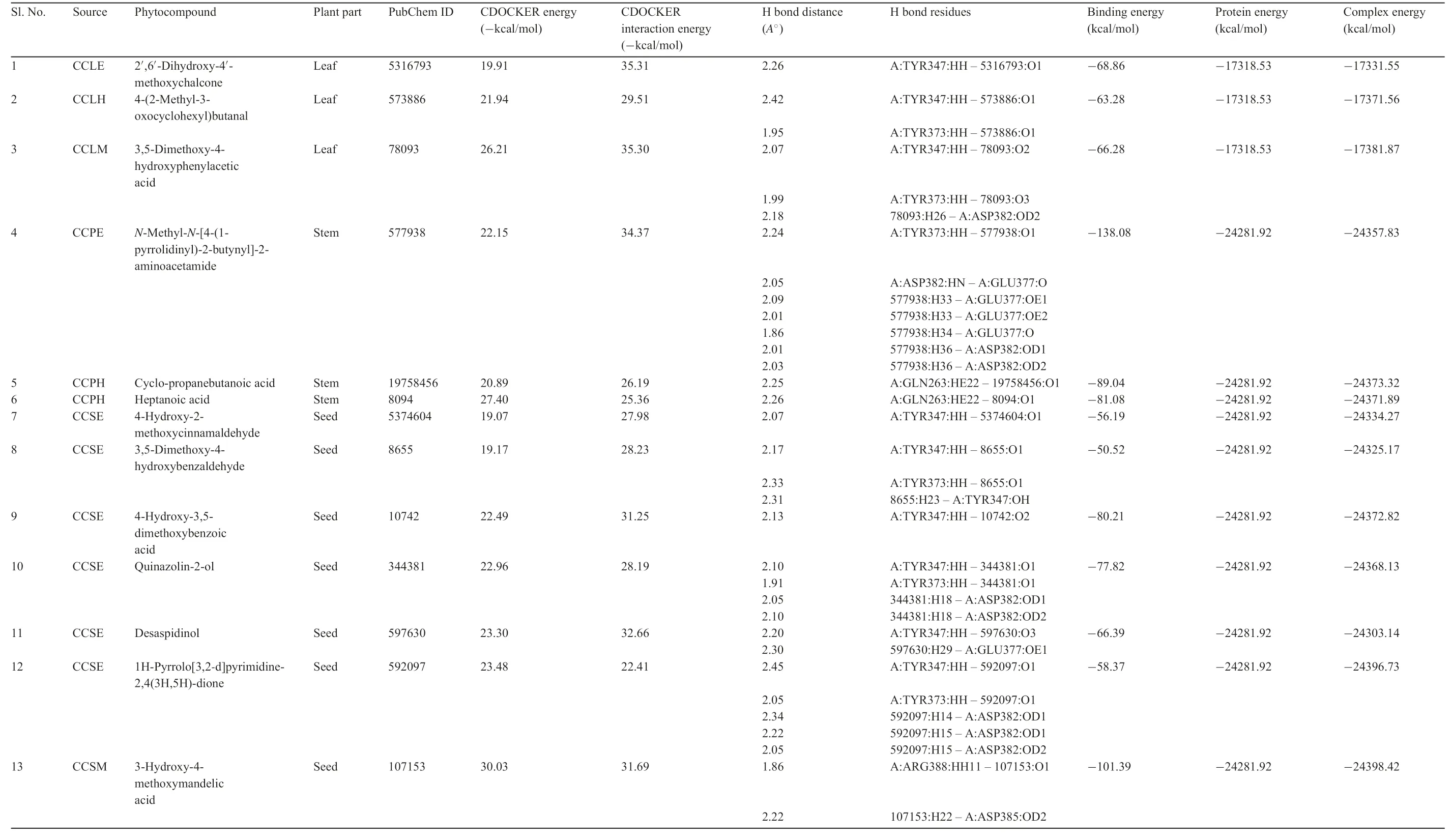
Table3 Molecular docking scores of pigeon pea phytocompounds with arthritis target pro tein iNOSox (CCLE - Leaves Ethyl acetate extracted,CCLH - Leaves Hexane extracted,CCLM - Leaves Me hanol extracted,CCPE-Seeds Ethyl acetate extracted,CCPH-Seeds Hexane extracted,CCPM-Seeds Metha nol extracted,CCSE-Stems Ethyl acetate extracted,CCSH-Stems Hexane extracted,CCSM-Stems Methanol ext
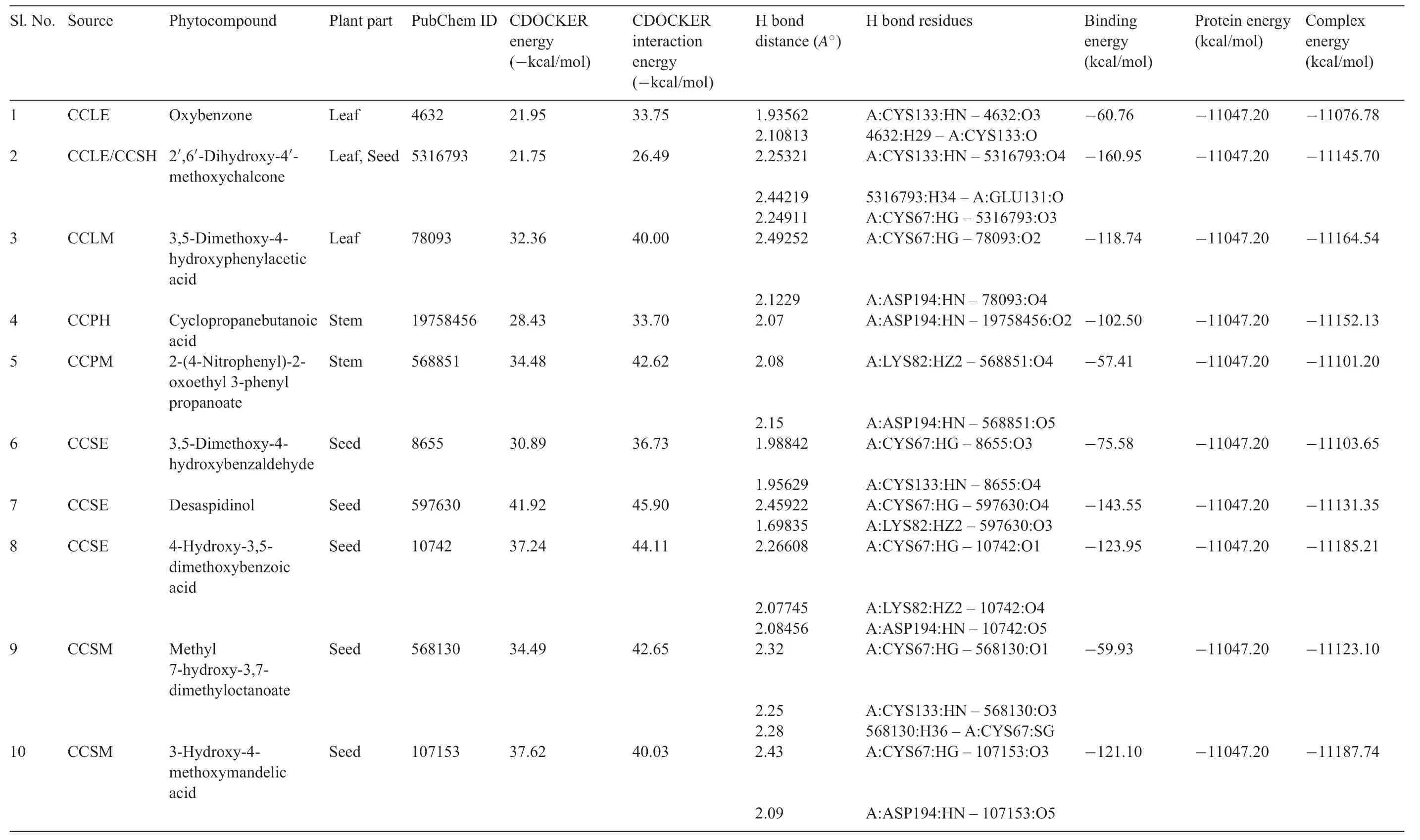
Table4 Molecular docking scores of pigeon pea phytocompounds with breast cancer target protein polo-like kinase 1.

Table5 Molecular docking scores of pigeon pea phytocompounds with type II diabetes target protein dipeptidyl peptidase IV.Table6 Molecular docking scores of pigeon pea phytocompounds with malaria target protein Plasmepsin II.
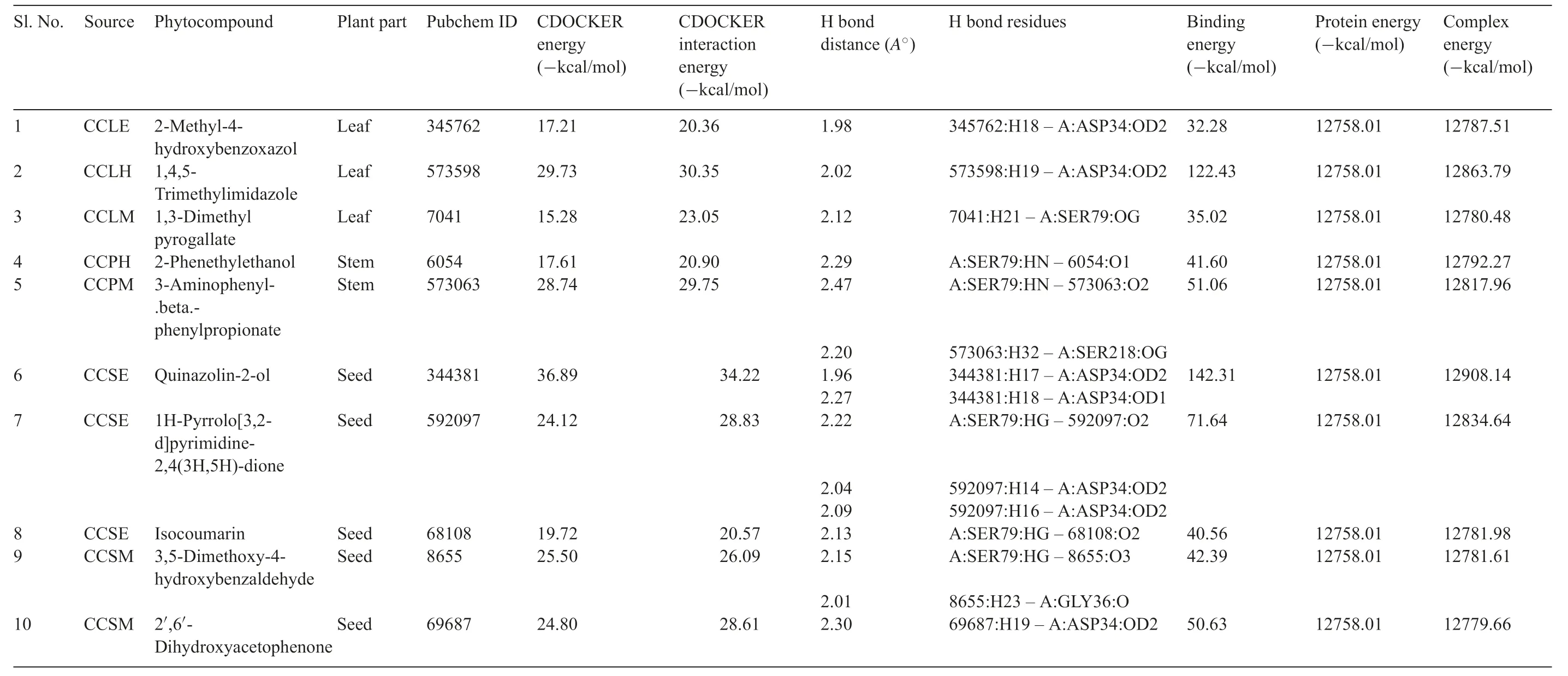
Table5 Molecular docking scores of pigeon pea phytocompounds with type II diabetes target protein dipeptidyl peptidase IV.Table6 Molecular docking scores of pigeon pea phytocompounds with malaria target protein Plasmepsin II.

Table7 Molecular docking scores of pigeon pea phytocompounds with measles target protein

Table8 Molecular docking scores of pigeon pea phytocompounds with sickle cell disease target protei
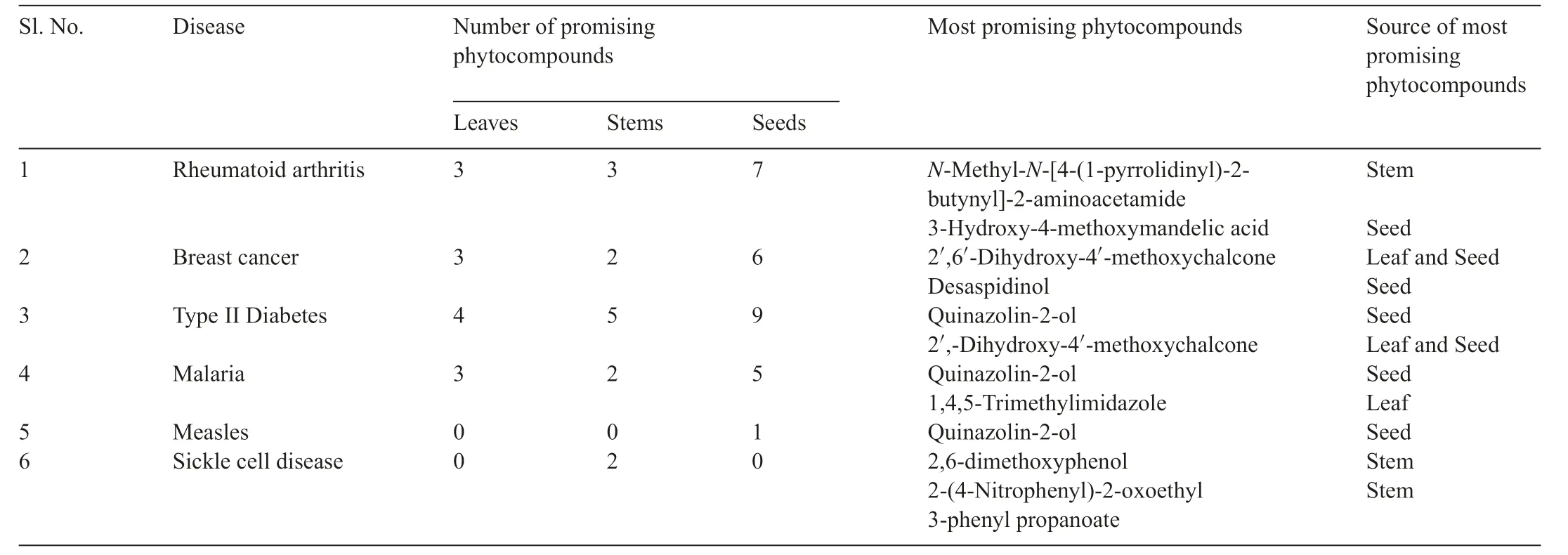
Table9 Docking summary showing the number of promising phytocompounds identifie from each part and the most promising molecules for each disease.
When these 30 molecules were further tested for their druglikeliness through ADMET analysis,26 were found successful(Table10).The most promising molecules 2′,6′-Dihydroxy-4′-methoxychalcone,N-Methyl-N-[4-(1-pyrrolidinyl)-2-butynyl]-2-aminoacetamide and 2-(4-Nitrophenyl)-2-oxoethyl 3-phenyl propanoate had high level solubility,BBB level and false hepato-toxicity.Among the molecules screened,only 1,4,5-Trimethylimidazole had absorption level of 1 and all the molecules had False CYP2D6 Prediction.
4.Discussion
Phyto-compounds and secondary metabolites have been therapeutically important since time immemorial [53].Emergence of resistance to antibiotics and adverse side effects associated with conventional drugs demands the search for new plant based drugs[54,55].Our study indicates that pigeon pea and especially its seeds are very rich sources for promising phyto-compounds.Though the molecules behind the action were unknown,various medicinal properties of pigeon pea were previously reported.Our finding throw light on the molecules behind the therapeutic potential of this crop,with many molecules having potential against multiple diseases.
Though many studies have established antidiabetic properties of pigeon pea [9,13],none detail the responsible active molecules.Present study reveals 18 antidiabetic molecules,thus establishing the scientifirationale for the activity.Similarly,its antiviral activity is known and in eastern Nigeria,leaf decoctions are used to treat measles[39].Though the antiviral activity of ethanolic and water extracts on measles and herpes diseases were previously shown[39,56],the molecules behind the action were unknown.This study has revealed that quinazolin-2-ol is the antiviral molecule in this crop.
Our results reveal ten novel molecules each for anticancer and antimalarial activities of this crop.So far,from pigeon pea,only cajanol was reported as anticancer molecule[19]and only longistylin A and C,and betulinic acid as antimalarial molecules[16].But our studies did not identify these molecules for their respective properties.
The seed extracts ofC.cajanis reported to have beneficia effects on sickle cell disease [43,57,58].Total plant extracts are also reported to have anti-sickling effects[59-61].Cajaminose [24],phenylalanine [62,63],and hydroxybenzoic acid [25,42]are identifie as the active molecules contributing to this property.The present study has identifie two novel molecules,2,6-dimethoxyphenol and 2-(4-Nitrophenyl)-2-oxoethyl 3-phenyl propanoate,from stem extracts to have anti-sickle cell properties.The replacement of amino acid in OxyHb protein of hemoglobin leads to its precipitation in erythrocytes,making erythrocytes rigid.The extracts of pigeon pea enhance the erythrocyte glutathione-S-transferase activity[64]and haemoglobin gelation and oxygen affinit [58],leading to the anti-sickling action.
Among the molecules studied,desaspidinol was most promising with its potential against arthritis,diabetes and breast cancer.This molecule belonging to the phloroglucinol family and abundantly present inDryopterisfern,was previously identifie for its antihelminthic [65,66]and antibacterial activities[67].Assignment of anti-tumour activity of fern extract to its major component desaspidinol[68],explains the action of this molecule against breast cancer.Gerhäuser and Frank[69]have further confirme the anticancer property of desaspidinol.Basis for the anti-diabetic activity of this molecule was its stronguncoupling effect on oxidative phosphorylation[70].The antiinflammator activity ofLeucosideahas been attributed to its phtocompound desaspidinol and this capability should further offer to the anti-arthritic potential of this molecule[71].
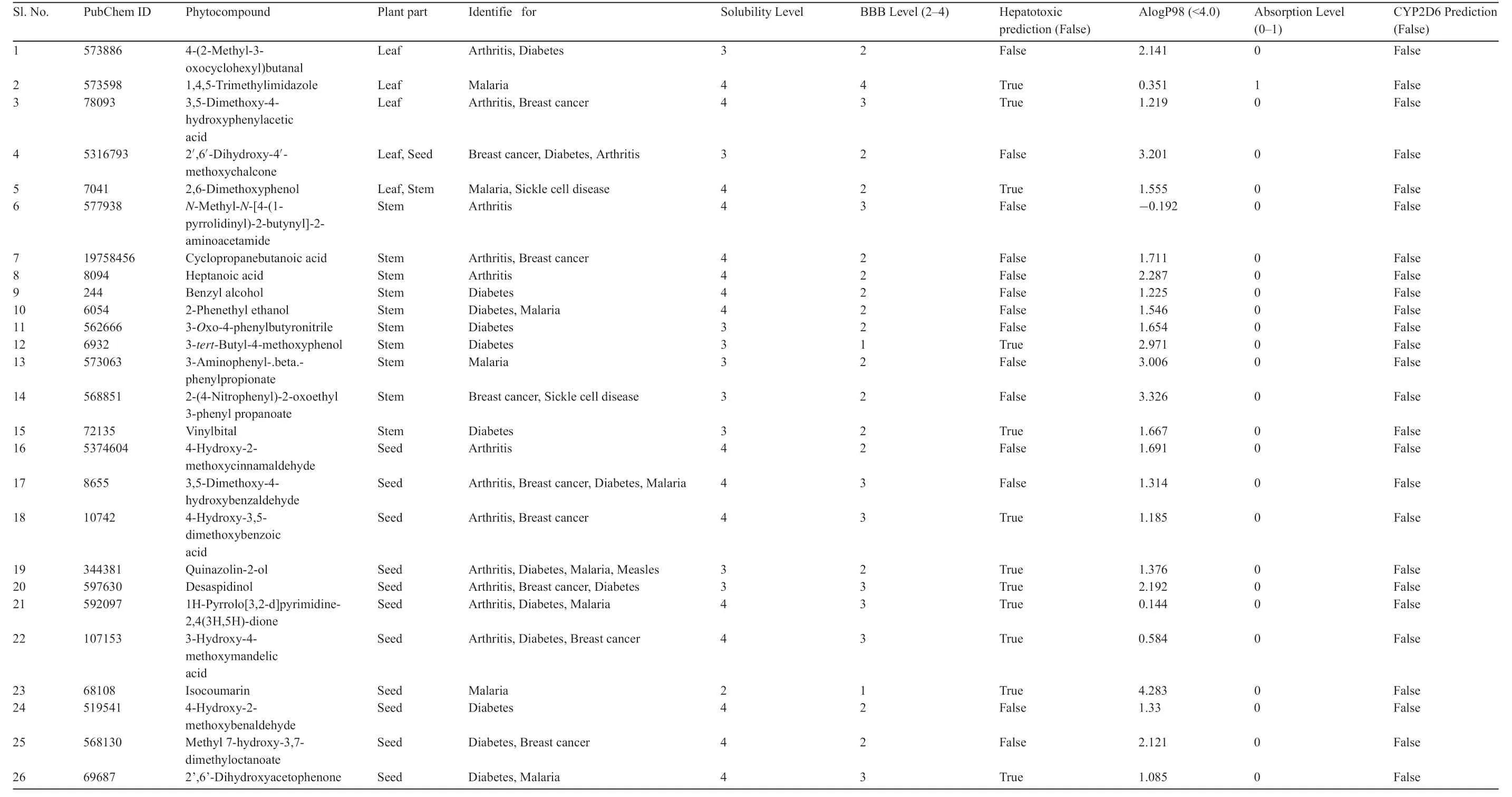
Table10 ADMET values for 26 phytocompounds which have passed the drug-likeliness screening(Desirable values are presented in b
Quinazolin-2-ol which was found to have potential against arthritis,diabetes,malaria and measles has been identifie for its strong anti-oxidant properties [72].This molecule has a heterocyclic ring system of which six-members are reported for their biological activities and multiple pharmacophores.Quinazolin derivatives were previously proven to have antitumour[73],antibacterial[74],anti-inflammator and anticancer[75],antihypertensive,antihyperlipidemic,antitubercular,central nervous system depressant,analgesic,antimalarial medicinal properties [76].Hundreds of medicinal properties shown by multiple quinazolin derivatives[77]explain the potential shown by this molecule against multiple human diseases.
Compound 3,5-dimethoxy-4-hydroxyphenylacetic acid,commonly known as homosyringic acid,had given satisfactory interaction with target proteins of RA and breast cancer.Even though this compound is reported fromCinnamomum cassia,bamboo andPhyllostachys[78]and understood as a biomass pyrolysis product,its medicinal properties were so far unknown.The moleculeN-Methyl-N-[4-(1-pyrrolidinyl)-2-butynyl]-2-aminoacetamide had potential against arthritis.In human system,this molecule congeners as muscarinic agent to coordinate the internal organs [79]and this could explain its role in arthritis treatment.
The molecule 3-hydroxy-4-methoxymandelic acid which was identifie for its potential against arthritis,breast cancer and diabetes,has also been used as an important constituent of a topical preparation to treat ocular hypertension,glaucoma,ischemic retinopathy and age-related macular degeneration[80].The molecule 1H-Pyrrolo[3,2-d]pyrimidine-2,4(3H,5H)-dione had potential against arthritis,diabetes and malaria.Derivatives of this molecule are known for their adenosine receptor antagonist activity in mammalian systems[81].Molecules with this property are reported to be useful for wide medical applications such as bronchodialators,cardiotonics,diuretics and central nervous system activators[82].
The present study has also revealed that 1,4,5-trimethyl imidazole present in the leaves of pigeon pea has the potential to treat malaria.Imidazole is a planar fie-member heterocyclic ring which is constituent of several important natural products,including purine,histamine,histidine and nucleic acid.Being a polar and ionisable aromatic compound,it improves pharmacokinetic characteristics oflead molecules and thus used as a remedy to optimize solubility and bioavailability parameters of poorly soluble lead molecules[83].Trimethyl imidazole derivatives were previously shown to possess antibacterial and antioxidant [84]and anti-protozoal [85]properties.Numerous methods for the synthesis ofimidazole and also their various structure reactions offer enormous scope in the fiel of medicinal chemistry.
The compound 2′,6′-Dihydroxy-4′-methoxychalcone(DMC) has been previously identifie fromPiper aduncuminflorescence through dichloromethane extract and was selectively toxic to the parasites[86].Its simple structure may well enable it to serve as a new lead compound for the synthesis of novel anti-leishmanial drugs.Neuroprotective effects and antioxidant activities of DMC are also reported[87].Chalcones are flvonoids present in a variety of plant species with a wide range of biological effects,including antibacterial,antitumor,antifungal [88,89],antiviral [90],and anti-plasmodial [91]activities.
Syringol,also called 2,6-dimethoxyphenol,was found to have potential against malaria and sickle cell disease.This molecule isolated from canola oil had antioxidative and antimutagenic activities [92]and further,it was found to suppress oxidative stress and gastric carcinogenesis [93].Thus,the molecules identifie in this study are having profound proven biological properties and hence worth forwarding them to thein vivoanalysis of drug suitability.However,the non-availability of tertiary structures of a large number of phyto-compounds in the public databases such as PubChem is a major bottleneck in studies of this kind.
5.Conclusions
This study has proven the research hypothesis by revealing the spectrum of phyto-compounds in various parts of pigeon pea plant and proving the therapeutic potential oflarge number of molecules against multiple human diseases such as rheumatoid arthritis,breast cancer,diabetes,malaria,measles and sickle cell disease.The study has especially revealed that the pigeon pea seed is a profound source of molecules which could be used to treat many diseases.The molecular docking ofligands followed by ADMET analysis has led to the identificatio of 26 promising molecules,of which Quinazolin-2-ol,Desaspidinol,2-(4-Nitrophenyl)-2-oxoethyl 3-phenyl propanoate,3-Hydroxy-4-methoxymandelic acid,2′,6′-Dihydroxy-4′-methoxychalcone,2,6-Dimethoxyphenol,1,4,5-Trimethylimidazole,N-Methyl-N-[4-(1-pyrrolidinyl)-2-butynyl]-2-aminoacetamide were most promising for multiple diseases and hence are recommended to be carried forward to thein vivodrug suitability analyses.Further works have to be carried out to deposit the tertiary structures of more phyto-compounds in databases,carry out the molecular docking of the identifie phyto-compounds with the target proteins of other major diseases and to identify the drug candidates and to carry forward the candidate molecules identifie from this study toin vivostudies and drug formulation.
Conflict ofinterests
Authors declare that there are no conflic ofinterests
Acknowledgements
Authors thank Planning Board,Government of Kerala,India,for the financia support to this research work through the project Establishing Finishing School in Biotechnology in Kerala
Appendix A.Supplementary data
Supplementary data associated with this article can be found,in the online version,at http://dx.doi.org/10.1016/j.fshw.2017.09.003.
- 食品科学与人类健康(英文)的其它文章
- Effects of Soursop flwers(Annona muricata L.)extract on chemical changes of refine palm olein stored at frying temperature
- About the Beijing Academy of Food Sciences
- A synthetic biological secondary metabolite,LycogenTM,produced and extracted from Rhodobacter sphaeroides WL-APD911 in an optimizatioal scale-up strategy
- Establishment of probabilistic model for Salmonella Enteritidis growth and inactivation under acid and osmotic pressure
- Terminalia arjuna:A novel natural preservative for improved lipid oxidative stability and storage quality of muscle foods
- Comparison of chicoric acid,and its metabolites caffeic acid and caftaric acid:In vitro protection of biological macromolecules and inflammator responses in BV2 microglial cells

